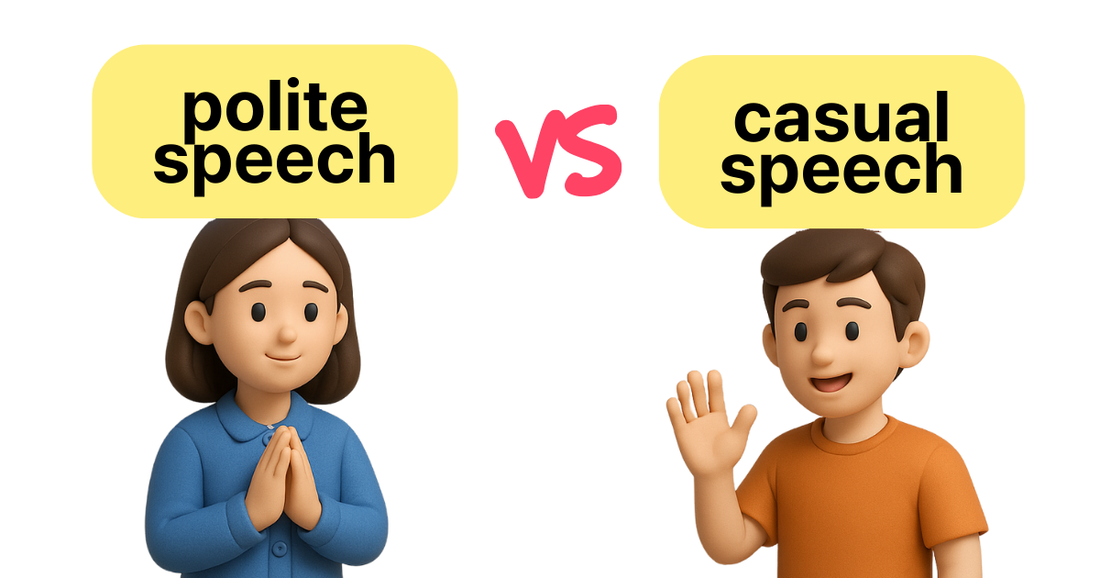
Master Korean Politeness in 5 Minutes: 존댓말 vs 반말 Made Simple
Share
If you're learning Korean, one of the first cultural lessons you'll run into is how important respect is in daily conversations. And that’s exactly what makes Korean honorifics—or polite speech—so fascinating (and sometimes confusing)!
Let’s explore two essential speech styles: 존댓말 (jon-daen-mal, polite speech) and 반말 (ban-mal, informal speech). This guide will help you understand when to use them, how to switch between them, and give you everyday examples.
What Are 존댓말 and 반말?
존댓말 [jon-daen-mal] – Polite Speech
Polite speech is used to show respect—especially toward older people, strangers, and in professional settings.
-
Sentences usually end in -요 [-yo] or -습니다 [-seum-ni-da]
-
Example: 안녕하세요? [an-nyeong-ha-se-yo?] = “Hello (polite)”
반말 [ban-mal] – Casual Speech
Used between close friends, peers, or those younger than you. It feels relaxed and direct.
-
Sentences are shorter, with endings like -야 or dropped particles
-
Example: 안녕! [an-nyeong!] = “Hey!”
💡 Quick Tip: Start with 존댓말 unless you're 100% sure 반말 is okay. It’s always safer!
Real-Life Examples: Polite vs. Casual
Let’s break it down with some useful phrases you might use:
| Situation | Polite (존댓말) | Casual (반말) |
|---|---|---|
| Greeting | 안녕하세요? [an-nyeong-ha-se-yo?] | 안녕! [an-nyeong!] |
| Saying Thank You | 감사합니다 [gam-sa-ham-ni-da] | 고마워 [go-ma-wo] |
| Apologizing | 죄송합니다 [joe-song-ham-ni-da] | 미안해 [mi-an-hae] |
| Asking Questions | 어디 가세요? [eo-di ga-se-yo?] | 어디 가? [eo-di ga?] |
| Agreeing | 네, 맞아요. [ne, ma-ja-yo.] | 응, 맞아. [eung, ma-ja.] |
| Excitement | 좋아요! [jo-a-yo!] | 좋아! [jo-a!] |
✔ 존댓말 softens your tone and shows respect.
✔ 반말 feels friendly and close—but should be used carefully.
When to Use Each Style
✅ Use 존댓말 When:
-
Talking to older people
→ “선배님, 안녕하세요!” [seon-bae-nim, an-nyeong-ha-se-yo!] -
Meeting someone for the first time
→ “어디에서 오셨어요?” [eo-di-e-seo o-syeo-sseo-yo?] -
In formal settings (work, school, interviews)
→ “회의가 시작되었습니다.” [hoe-ui-ga si-jak-dwae-sseum-ni-da.] -
Speaking to strangers or service staff
→ “이거 얼마예요?” [i-geo eol-ma-ye-yo?]
💡 When in doubt, start with 존댓말. You can always switch later.
✅ Use 반말 When:
-
With close friends or same-age peers
→ But always start with 존댓말 and switch naturally! -
With younger family members
→ Siblings and cousins often use 반말. -
Once you've been invited to
→ Try asking: “우리 반말해도 될까?” [u-ri ban-mal-hae-do doel-kka?] = “Can we talk casually?”
⚠ Switching too early can sound rude—always check first!
How to Switch from 존댓말 to 반말
Here’s a simple way to change your sentence from polite to casual:
| Polite (존댓말) | Casual (반말) |
|---|---|
| 밥 먹었어요? [bab meo-geo-sseo-yo?] | 밥 먹었어? [bab meo-geo-sseo?] |
| 어디 가세요? [eo-di ga-se-yo?] | 어디 가? [eo-di ga?] |
| 잘 지내세요? [jal ji-nae-se-yo?] | 잘 지내? [jal ji-nae?] |
| 학생입니다. [hak-saeng-im-ni-da.] | 학생이야. [hak-saeng-i-ya.] |
Be gentle when switching styles—especially with people you don’t know well!
Try It Yourself! ✍️
Can you rewrite these polite sentences in 반말? Leave your answers in the comments!
-
이거 얼마예요? → ❓
-
잘 지냈어요? → ❓
-
도와드릴까요? → ❓
-
맛있어요! → ❓
Final Thoughts
Korean is a beautiful language that values respect.
By learning when and how to use 존댓말 and 반말, you’re not just learning grammar—you’re building deeper connections with Korean speakers.
📩 Want more tips like this?
Subscribe to our newsletter and get weekly Korean expressions, cultural tips, and simple recipes straight to your inbox!
